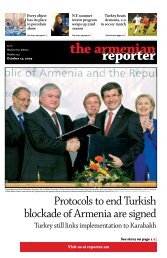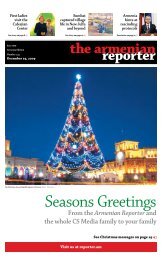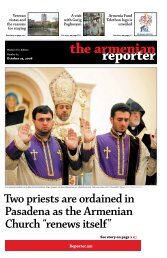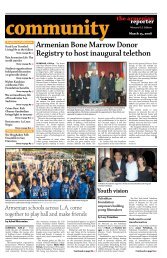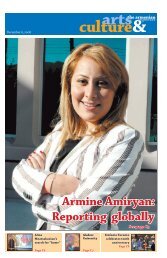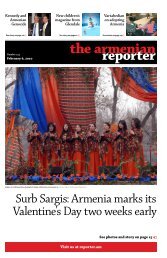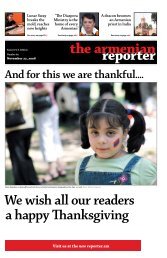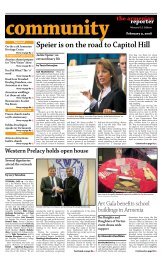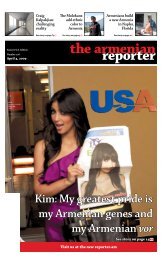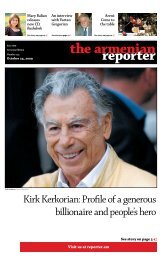Mihran's Mafia Style - Armenian Reporter
Mihran's Mafia Style - Armenian Reporter
Mihran's Mafia Style - Armenian Reporter
Create successful ePaper yourself
Turn your PDF publications into a flip-book with our unique Google optimized e-Paper software.
The new capital of the diaspora<br />
Patrick Azadian.<br />
my words<br />
by Patrick Azadian<br />
Not much had remained of the final<br />
capital of the <strong>Armenian</strong> diaspora.<br />
There were no street names<br />
marking the existence of this<br />
group who at some point accounted<br />
for nearly half the population<br />
of the city.<br />
Street names were what they’d<br />
always been: Colorado, Broadway,<br />
Milford, San Fernando, Verdugo.<br />
Ethnic grocery stores had disappeared.<br />
There were no more bilingual<br />
or trilingual signs. No one<br />
could read the second language<br />
any more.<br />
Taste buds had evolved.<br />
But the flagship ethnic store was<br />
still standing on Pacific. For the<br />
last 80 years, Pacific Food Mart<br />
had experienced a transformation.<br />
It had morphed into a national<br />
chain that carried foods satisfying<br />
the taste buds of the Midwest and<br />
Latinos. The soumagh (Persianstyle<br />
red spice), lavash (the Middle-Eastern<br />
bread), and the marinated<br />
kebobs had been replaced<br />
by cayenne pepper, tortillas, and<br />
hamburger patties.<br />
The older generation was either<br />
in heaven or hell. The parks in the<br />
south of the city were not buzzing<br />
to the sounds of backgammon.<br />
You couldn’t hear “shesh,<br />
besh...”<br />
The building called the “Youth<br />
Center” on the corner of Central<br />
and Chestnut was now up for sale<br />
to the Albanians.<br />
Just like their predecessor<br />
groups, they were here to make<br />
a new life for themselves in what<br />
was once described as the “Jewel<br />
City.” They also wanted to preserve<br />
their identity and heritage.<br />
It was exactly 80 years ago, on<br />
December 16, 2007, when the<br />
groundbreaking ceremony of the<br />
Youth Center had taken place.<br />
ttt<br />
I was dressed too warm for the<br />
occasion. That’s the problem with<br />
Southern California; you never<br />
know when it’s going to be cold,<br />
hot, or in between.<br />
I could not complain. I’d just<br />
spoken to my cousin Arné in New<br />
York City. He had been up all night<br />
keeping an eye on the level of<br />
snow in front of his family’s building.<br />
It was the landlord’s responsibility<br />
to shovel the snow off the<br />
sidewalk. I did not envy his morning<br />
adventure in the snow.<br />
Harmandian had been<br />
wrong when he’d sang,<br />
“Lipanan, im verchin<br />
hankrvan.” Lebanon was<br />
not <strong>Armenian</strong>s’ final<br />
port of call.<br />
As I walked into where the<br />
groundbreaking ceremony was to<br />
take place for the “Youth Center,”<br />
a teenager got my attention.<br />
“Orartsuyts” she asked. I had<br />
tried to ignore the table, but it<br />
was too late. The <strong>Armenian</strong> Youth<br />
Federation was selling calendars<br />
filled with pictures of Karabakh. I<br />
inquired about the price.<br />
“Ksan dolar” ($20), I was told.<br />
As an ex-AYFer, I could not say<br />
no. Besides, the number of $20<br />
bills I had spent on short-term<br />
pleasure the night before gave me<br />
a guilty feeling.<br />
I bought a calendar. The cover<br />
said: “Artsakh 2008!”<br />
I made my way through the<br />
crowd. Kids in dark blue scout uniforms<br />
were running around doing<br />
what kids do. Parents had one eye<br />
on the orators, and the other on<br />
their children.<br />
It was a momentous occasion. The<br />
new capital of the <strong>Armenian</strong> diaspora<br />
was finally going to have a community<br />
center. Within two years the<br />
center would be able to house many<br />
of community’s organizations.<br />
Within a period of 30 years, the<br />
heartbeat of the diaspora had<br />
shifted from Beirut, Tehran, and<br />
Aleppo to the Los Angeles area.<br />
And the epicenter of this monumental<br />
shift was the city of Glendale<br />
with its population of over<br />
80,000 <strong>Armenian</strong>s.<br />
Addis Harmandian (a 1970s <strong>Armenian</strong><br />
pop star) had been wrong<br />
when he’d sang: “Lipanan, Lipanan,<br />
im verchin hankrvan” (Lebanon,<br />
Lebanon, my last resting<br />
place/destination).<br />
According to the speeches, the<br />
American-<strong>Armenian</strong> community<br />
had now become the most important<br />
segment of the diaspora.<br />
With its numbers and financial<br />
muscle it was installed as the firm<br />
favorite to lead the way to a better<br />
future for the <strong>Armenian</strong> people<br />
as well as helping the <strong>Armenian</strong><br />
state prosper.<br />
The groundbreaking ceremony<br />
was a new beginning for the community.<br />
In years gone by, many<br />
such wholehearted ceremonies had<br />
already taken place in Beirut, Paris,<br />
Lvov, Tehran, Aleppo, and Cairo.<br />
But there were two major differences.<br />
First, there was now an<br />
<strong>Armenian</strong> state.<br />
And second, this was now the<br />
final destination for the Armenia<br />
diaspora. There was no other viable<br />
alternative for migration.<br />
There was no margin for error.<br />
Standing there, I watched the<br />
men in their symbolic construction<br />
helmets perform the groundbreaking.<br />
In a half a century or so,<br />
would this capital be considered<br />
the morgue of what was left of the<br />
<strong>Armenian</strong> diaspora, or would it be<br />
the catalyst for a brighter future<br />
History favors the former. But<br />
hopefully there are some exceptions<br />
to the rule.<br />
f<br />
C22 <strong>Armenian</strong> <strong>Reporter</strong> Arts & Culture 12/22/2007



